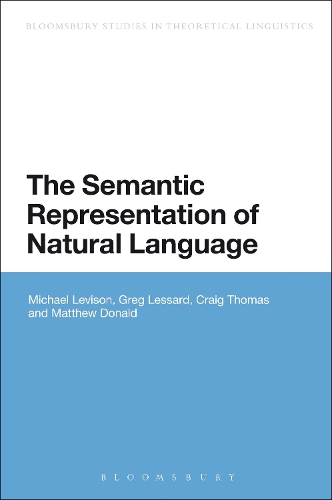
The Semantic Representation of Natural Language
(Paperback)
Available Formats
Publishing Details
The Semantic Representation of Natural Language
By (Author) Michael Levison
By (author) Greg Lessard
By (author) Craig Thomas
By (author) Matthew Donald
Bloomsbury Publishing PLC
Bloomsbury Academic
26th June 2014
United Kingdom
Classifications
Tertiary Education
Non Fiction
401.43
Physical Properties
Paperback
352
Width 156mm, Height 234mm
376g
Description
This volume contains a detailed, precise and clear semantic formalism designed to allow non-programmers such as linguists and literary specialists to represent elements of meaning which they must deal with in their research and teaching. At the same time, by its basis in a functional programming paradigm, it retains sufficient formal precision to support computational implementation. The formalism is designed to represent meaning as found at a variety of levels, including basic semantic units and relations, word meaning, sentence-level phenomena, and text-level meaning. By drawing on fundamental principles of program design, the proposed formalism is both easy to read and modify yet sufficiently powerful to allow for the representation of complex semantic phenomena. In this monograph, the authors introduce the formalism and show its basic structure, apply it to the analysis of the semantics of a variety of linguistic phenomena in both English and French, and use it to represent the semantics of a variety of texts ranging from single sentences, to textual excepts, to a full story.
Reviews
Levison et al. present a useful meaning representation framework ... superior in both human-readability (especially by non-specialists) and in its representation of discourse structures beyond the sentence-level. These are important features and ... contribute to the greater usefulness of this framework for non-computational linguists. -- Jonathan Dunn * Studies in Language *
[This book] provides a practical formal representation of the meaning of expressions of natural language, from basic semantic units to texts, which, commendably, relies closely on recent results within various contemporary theories and applications within lexical semantics, such as componential analysis, conceptual structures ... as well as various truth-conditional approaches to sentence meaning. * The Year's Work in English Studies *
At last a book on natural language semantics that tackles semantics all the way up to texts of considerable length and fictional statements. The proposed formalism brings together well tried solutions for specific linguistic phenomena with a structural approach based on programming languages that makes it user friendly and gives it tremendous expressive power. A very useful contribution for natural language generation and the representation of narrative. -- Pablo Gervs, Associate Professor, Universidad Complutense de Madrid, Spain
Semantic Representations of Natural Language provides a highly suggestive survey of the multiple relationships between semantic analysis and computational formalization of natural language and narratives, offering a vivid, nearly kaleidoscopic, theoretically comprehensive and strongly argued synthesis of a long lasting team approach. Even literature researchers concerned with the digital analysis of textuality will read this monograph with the greatest interest. -- Jean-Pierre Dubost, Emeritus Professor, Universit Blaise Pascal, France
Genuine interdisciplinary research between linguistics, literary studies and computational approaches is rare. The research detailed here is an example of such interdisciplinary collaboration at its best. Technical, but enjoyable, this is a book to be read and thought about as it opens many new vistas. -- Geoffrey Williams, Professor, Universit De Bretagne-Sud, France
Author Bio
Michael Levison is a Professor Emeritus in the School of Computing at Queen's University, Canada. Greg Lessard is a Professor in the Department of French Studies at Queen's University, Canada. Craig Thomas earned his PhD from the School of Computing at Queen's University, Canada, in 2010 under the supervision of Michael Levison and Greg Lessard. Matthew Donald earned his MSc from the School of Computing at Queen's University, Canada, in 2006 under the direction of Michael Levison and Greg Lessard.
